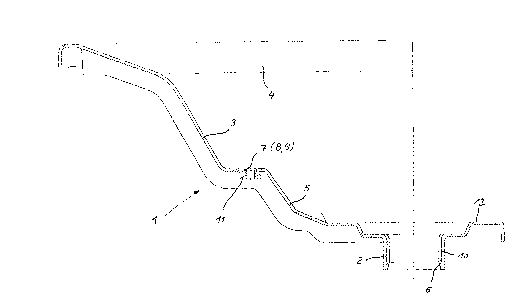Some of the information on this Web page has been provided by external sources. The Government of Canada is not responsible for the accuracy, reliability or currency of the information supplied by external sources. Users wishing to rely upon this information should consult directly with the source of the information. Content provided by external sources is not subject to official languages, privacy and accessibility requirements.
Any discrepancies in the text and image of the Claims and Abstract are due to differing posting times. Text of the Claims and Abstract are posted:
| (12) Patent: | (11) CA 2208858 |
|---|---|
| (54) English Title: | SHEET-METAL STEERING WHEEL |
| (54) French Title: | VOLANT EN TOLE |
| Status: | Expired and beyond the Period of Reversal |
| (51) International Patent Classification (IPC): |
|
|---|---|
| (72) Inventors : |
|
| (73) Owners : |
|
| (71) Applicants : |
|
| (74) Agent: | ROBIC AGENCE PI S.E.C./ROBIC IP AGENCY LP |
| (74) Associate agent: | |
| (45) Issued: | 2001-02-06 |
| (22) Filed Date: | 1997-06-20 |
| (41) Open to Public Inspection: | 1997-12-21 |
| Examination requested: | 1997-09-23 |
| Availability of licence: | N/A |
| Dedicated to the Public: | N/A |
| (25) Language of filing: | English |
| Patent Cooperation Treaty (PCT): | No |
|---|
| (30) Application Priority Data: | |||||||||
|---|---|---|---|---|---|---|---|---|---|
|
A steering-wheel skeleton has a hub, spokes, and a rim
made in one piece out of a single sheet-metal blank and
provided with its final shape by separation and bending
without machining. The hub is provided with a cone facing the
vehicle. The spokes, which extend up and out, are provided
with unthreaded bores, cutouts, or threaded bore for
attaching an airbag module. A nut can, if necessary, be
forced into one cutout. The hub can be reinforced by using
two layers of the material.
Note: Claims are shown in the official language in which they were submitted.
Note: Descriptions are shown in the official language in which they were submitted.

2024-08-01:As part of the Next Generation Patents (NGP) transition, the Canadian Patents Database (CPD) now contains a more detailed Event History, which replicates the Event Log of our new back-office solution.
Please note that "Inactive:" events refers to events no longer in use in our new back-office solution.
For a clearer understanding of the status of the application/patent presented on this page, the site Disclaimer , as well as the definitions for Patent , Event History , Maintenance Fee and Payment History should be consulted.
| Description | Date |
|---|---|
| Time Limit for Reversal Expired | 2003-06-20 |
| Letter Sent | 2002-06-20 |
| Grant by Issuance | 2001-02-06 |
| Inactive: Cover page published | 2001-02-05 |
| Inactive: Final fee received | 2000-10-27 |
| Pre-grant | 2000-10-27 |
| Notice of Allowance is Issued | 2000-09-11 |
| Letter Sent | 2000-09-11 |
| Notice of Allowance is Issued | 2000-09-11 |
| Inactive: Approved for allowance (AFA) | 2000-08-16 |
| Amendment Received - Voluntary Amendment | 2000-07-21 |
| Inactive: S.30(2) Rules - Examiner requisition | 2000-02-14 |
| Letter Sent | 1998-03-10 |
| Letter Sent | 1998-03-10 |
| Application Published (Open to Public Inspection) | 1997-12-21 |
| Inactive: Multiple transfers | 1997-12-17 |
| All Requirements for Examination Determined Compliant | 1997-09-23 |
| Inactive: Single transfer | 1997-09-23 |
| Request for Examination Received | 1997-09-23 |
| Inactive: First IPC assigned | 1997-09-23 |
| Classification Modified | 1997-09-23 |
| Inactive: IPC assigned | 1997-09-23 |
| Request for Examination Requirements Determined Compliant | 1997-09-23 |
| Filing Requirements Determined Compliant | 1997-09-05 |
| Inactive: Filing certificate - No RFE (English) | 1997-09-05 |
| Application Received - Regular National | 1997-09-04 |
| Inactive: Courtesy letter - Evidence | 1997-09-04 |
There is no abandonment history.
The last payment was received on 2000-04-06
Note : If the full payment has not been received on or before the date indicated, a further fee may be required which may be one of the following
Please refer to the CIPO Patent Fees web page to see all current fee amounts.
| Fee Type | Anniversary Year | Due Date | Paid Date |
|---|---|---|---|
| Application fee - standard | 1997-06-20 | ||
| Registration of a document | 1997-09-23 | ||
| Request for examination - standard | 1997-09-23 | ||
| Registration of a document | 1997-12-17 | ||
| MF (application, 2nd anniv.) - standard | 02 | 1999-06-21 | 1999-03-23 |
| MF (application, 3rd anniv.) - standard | 03 | 2000-06-20 | 2000-04-06 |
| Final fee - standard | 2000-10-27 | ||
| MF (patent, 4th anniv.) - standard | 2001-06-20 | 2001-04-04 |
Note: Records showing the ownership history in alphabetical order.
| Current Owners on Record |
|---|
| TRW AUTOMOTIVE SAFETY SYSTEMS GMBH |
| Past Owners on Record |
|---|
| HERIBERT WERNER |
| KLAUS DREFAHL |
| MARTIN KREUZER |
| PETER HARTMANN |
| UDO LIESENFELD |